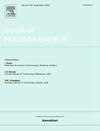Analysis and optimization of operating characteristics for integrated pressurized water reactor IP200
IF 2.3
3区 工程技术
Q1 NUCLEAR SCIENCE & TECHNOLOGY
引用次数: 0
Abstract
The integrated pressurized water reactor exhibits superior performance in terms of safety, economy, and modular implementation. However, the structural differences of the integrated pressurized water reactor make its operation more complex compared to traditional pressurized water reactors. This paper established a model for the integrated pressurized water reactor IP200 and analyzed the characteristics of typical operating conditions. Furthermore, the optimization of operational strategies for typical transient process was carried out based on intelligent algorithms. Specifically, the transient operational characteristics of the IP200 was analyzed by nuclear-thermal coupling method. During the step load change under forced circulation, the IP200 could achieve a rapid response within 40 s and reach a new stable state. However, the transition time during the transition from forced circulation to natural circulation was 461 s, exceeding the maneuverability indicators. Therefore, the paper used a multi-population genetic algorithm to optimize the operational strategies and obtained the optimal transition time. Under optimized operational strategy, the initial conversion power, average reactor temperature, and shut-off interval time of main coolant pump were 31.78 %FP, 572.48 K, and 0 s, respectively. The conversion time was reduced to 381 s, which was 17.4 % shorter than before, achieving thermal safety and maneuverability requirements.
IP200一体化压水堆运行特性分析与优化
一体化压水堆在安全性、经济性和模块化实施方面表现出优越的性能。然而,整体压水堆的结构差异使得其运行比传统的压水堆更为复杂。建立了IP200一体化压水堆的模型,分析了典型工况的特点。在此基础上,基于智能算法对典型瞬态过程的运行策略进行了优化。具体而言,采用核-热耦合方法分析了IP200的瞬态运行特性。在强制循环的阶跃负荷变化过程中,IP200能在40 s内实现快速响应,达到新的稳定状态。从强迫环流到自然环流的过渡时间为461 s,超过了可操作性指标。因此,本文采用多种群遗传算法对操作策略进行优化,得到了最优过渡时间。优化后的运行策略下,初始转换功率为31.78% FP,反应堆平均温度为572.48 K,主冷却剂泵关闭间隔时间为0 s。转换时间缩短到381 s,比原来缩短了17.4%,达到了热安全性和机动性要求。
本文章由计算机程序翻译,如有差异,请以英文原文为准。
求助全文
约1分钟内获得全文
求助全文
来源期刊

Annals of Nuclear Energy
工程技术-核科学技术
CiteScore
4.30
自引率
21.10%
发文量
632
审稿时长
7.3 months
期刊介绍:
Annals of Nuclear Energy provides an international medium for the communication of original research, ideas and developments in all areas of the field of nuclear energy science and technology. Its scope embraces nuclear fuel reserves, fuel cycles and cost, materials, processing, system and component technology (fission only), design and optimization, direct conversion of nuclear energy sources, environmental control, reactor physics, heat transfer and fluid dynamics, structural analysis, fuel management, future developments, nuclear fuel and safety, nuclear aerosol, neutron physics, computer technology (both software and hardware), risk assessment, radioactive waste disposal and reactor thermal hydraulics. Papers submitted to Annals need to demonstrate a clear link to nuclear power generation/nuclear engineering. Papers which deal with pure nuclear physics, pure health physics, imaging, or attenuation and shielding properties of concretes and various geological materials are not within the scope of the journal. Also, papers that deal with policy or economics are not within the scope of the journal.
 求助内容:
求助内容: 应助结果提醒方式:
应助结果提醒方式:


